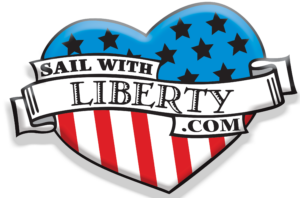Sailing Terminology You Should Know
There’s something about the water that will always pull us to the seas. Whether it’s the mystery of the great depths of the ocean or the movement of the ripples as the wind touches the surface, where there is water there will be people to explore it.
It’s no different in a breathtaking place like St. Thomas in the US Virgin Islands, where the warm water is a wonderfully clear turquoise, there are endless expanses of white sand beaches, and the open oceans tempt us with its many possibilities. And sailing the waters of St. Thomas is one of the best ways to see all that the oceans have to offer.
At Sailing With Liberty and Justice, we offer sailing charters in St. Thomas that allow visitors to get a glimpse of the beautiful open oceans and wildlife and to experience the many adventures of the Virgin Islands. With an experienced captain and first mate, you’ll get the tour of a lifetime on either our 44-foot ketch sailboat Liberty or our 25-foot catamaran Justice.
If you choose to charter the sailboat Liberty, then it will be a good idea to learn some basic sailing terms. This is not only useful when you want to impress your friends, but knowing these terms can actually help keep everyone on board safe during your journey. Even though you can put complete faith in Captain Ryan and his first mate Mumfy to skillfully sail the boat, these terms will get you in the sailing mood.
Getting to Know the Sailboat Itself
When referring to either side of the boat, it’s important to know that the port side or starboard are always the same, regardless of which direction you’re facing.
- Bow: This is the front of the boat.
- Stern: The back of the boat.
- Port: When standing at the back of the boat (stern) looking toward the front (bow) port side is the left side of the boat. When you’re at the bow and looking at the stern, port is on the right side.
- Starboard: The opposite of port, starboard, when you’re at the stern looking at the bow, is the right side of the boat.
- Helm: The helm is where the boat is steered. On larger boats, the helm can be a big wheel, while on smaller sailboats, the boat is often steered by a tiller.
Sailboat Movements
Sailboats rely on the wind to move and get to a desired location, so your sailing charter captain will use the wind to their advantage, often by tacking or jibing. You may hear the captain tell you to “prepare to tack” or “prepare to jibe.” It’s important to recognize these terms because when the boat is either tacking or jibing the sails are moving from side to side.
- Tack: Tacking the boat means to turn the bow of the boat through the wind.
- Jibe: Jibing the boat means to turn the stern of the boat through the wind.
- Heeling: If there is a particularly strong wind and the captain either jibes or tacks, heeling is when the boat leans over in the water. Don’t worry, though, you’re safe on board with us as catamarans don’t heel.
Features on the Sailboat
Even though you may not need to know these parts of the boat unless you’re actually sailing it, it’s still fun to be as familiar with the boat as possible.
- Mast: This is the main pole that holds up the sails. Small to medium-sized sailboats often have one mast, but larger boats can have two or more.
- Lines: In boating lingo, lines are what you would call “ropes.” Lines are pulled or let go when moving the sails.
- Mainsail: As the name implies, this is the largest sail on the boat and the most important. Along the bottom edge of the mainsail is a large pole called the boom. This is what you want to avoid when the boat is tacking or jibing.
- Jib: This is a smaller sail and is located near the mast. The jib doesn’t have a boom like a mainsail does.
Choose Sail With Liberty & Justice
Are you ready to take to the seas and explore the beauty of St. Thomas in the US Virgin Islands? If you love the open water, book a sailing charter with Sail With Liberty & Justice and get the experience of a lifetime.
